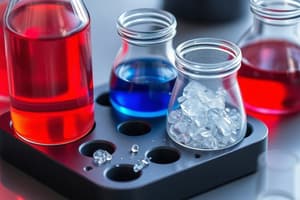Podcast
Questions and Answers
Which group of cations is characterized by having insoluble chlorides?
Which group of cations is characterized by having insoluble chlorides?
- Group V
- Group II
- Group I (correct)
- Group III
Which of the following cations forms a black precipitate when reacted with H2S?
Which of the following cations forms a black precipitate when reacted with H2S?
- Cu 2+ (correct)
- Bi 3+
- Hg2 2+
- Cd 2+ (correct)
Which chemical reagent is used to adjust the H+ concentration to 0.3 M in this analysis?
Which chemical reagent is used to adjust the H+ concentration to 0.3 M in this analysis?
- Sodium sulfide
- Hydrochloric acid (correct)
- Thioacetamide
- Acetic acid
What color precipitate is formed by the cation Cd 2+ when reacted with sulfide ions?
What color precipitate is formed by the cation Cd 2+ when reacted with sulfide ions?
What is the result of the reaction between Ag+ and HCl?
What is the result of the reaction between Ag+ and HCl?
Which compound can form a precipitate in a reaction involving magnesium from the alkaline earth group?
Which compound can form a precipitate in a reaction involving magnesium from the alkaline earth group?
What is the primary characteristic of the cations from Group 1 in relation to precipitation?
What is the primary characteristic of the cations from Group 1 in relation to precipitation?
Which reagent is used to precipitate Group 3 cations during the separation process?
Which reagent is used to precipitate Group 3 cations during the separation process?
After the precipitation of Group 1 cations, what should be done to the solution before adding H2S?
After the precipitation of Group 1 cations, what should be done to the solution before adding H2S?
What happens to the remaining cations after the addition of the precipitant for Group 4?
What happens to the remaining cations after the addition of the precipitant for Group 4?
Which alkaline earth metal is not included in the solubility category of Group II?
Which alkaline earth metal is not included in the solubility category of Group II?
Which step involves the use of sodium sulfide in the cation separation process?
Which step involves the use of sodium sulfide in the cation separation process?
Which of the following ions cannot form a precipitate with the common reagent NaOH?
Which of the following ions cannot form a precipitate with the common reagent NaOH?
What is the expected color of the precipitate when Sn 2+ is reacted with Na2S?
What is the expected color of the precipitate when Sn 2+ is reacted with Na2S?
Which sulfide is colored red and typically indicates the presence of mercuric ions?
Which sulfide is colored red and typically indicates the presence of mercuric ions?
What is the color of the precipitate formed from Sb 3+/5+ when reacted with sulfur compounds?
What is the color of the precipitate formed from Sb 3+/5+ when reacted with sulfur compounds?
Which reagent is used for the precipitation of Fe 2+/3+ ions to form FeS or Fe2S3?
Which reagent is used for the precipitation of Fe 2+/3+ ions to form FeS or Fe2S3?
Which of the following compounds represents the yellow precipitate formed from Sn 4+ ions?
Which of the following compounds represents the yellow precipitate formed from Sn 4+ ions?
In a flame test, which compound is indicative of the presence of sodium ions?
In a flame test, which compound is indicative of the presence of sodium ions?
What is the result of mixing Cu with hydrogen sulfide?
What is the result of mixing Cu with hydrogen sulfide?
What ion characterization is typically identified by the black precipitate?
What ion characterization is typically identified by the black precipitate?
Flashcards are hidden until you start studying
Study Notes
Cation Groups and Precipitation
- Group I: Cations that are insoluble in water and precipitate as chlorides.
- Members: Lead (Pb²⁺), Mercurous ion (Hg₂²⁺), and Silver (Ag⁺)
- Precipitant: 3M HCl (Hydrochloric acid)
- Group II: Cations that are insoluble in water and precipitate as sulfides, classified into subgroups.
- Subgroup: Copper (Cu²⁺), Bismuth (Bi³⁺), Cadmium (Cd²⁺), Lead (Pb²⁺)
- Precipitant: H₂S (Hydrogen sulfide)
- Subgroup: Tin (Sn²⁺ / Sn⁴⁺), Arsenic (As³⁺ / As⁵⁺), Antimony (Sb³⁺ / Sb⁵⁺), Mercury (Hg²⁺)
- Precipitant: Na₂S (Sodium sulfide)
- Group III: Cations that precipitate as sulfides in basic solution.
- Members: Iron (Fe²⁺ / Fe³⁺), Cobalt (Co²⁺), Nickel (Ni²⁺) and Manganese (Mn²⁺)
- Precipitant: (NH₄)₂S (Ammonium sulfide)
- Group IV: Cations that precipitate as carbonates in basic solution.
- Members: Magnesium (Mg²⁺), Calcium (Ca²⁺), Strontium (Sr²⁺), Barium (Ba²⁺)
- Precipitant: (NH₄)₂CO₃ (Ammonium carbonate)
- Group V: Cations that remain in solution.
- Members: Lithium (Li⁺), Sodium (Na⁺), Potassium (K⁺), Ammonium (NH₄⁺)
- Precipitant: None
Additional Key Points
- Insoluble Cations: NH₄Cl, NH₃, Mg²⁺, Ca²⁺, Sr²⁺, Ba²⁺, CaCO₃, SrCO₃, BaCO₃
- Solubilizing agents for Group II and III: Na₂S (Sodium sulfide), NaOH (Sodium hydroxide) and Na₂O₂ (Sodium Peroxide)
- Experiment #3 Overview: Cations are precipitated in groups by using specific precipitating agents, separating them from the solution.
- Precipitant: The substance used to cause the formation of a solid during the precipitation process.
- Centrifugate: The liquid that remains after centrifugation, containing the remaining cations that were not precipitated.
Studying That Suits You
Use AI to generate personalized quizzes and flashcards to suit your learning preferences.




